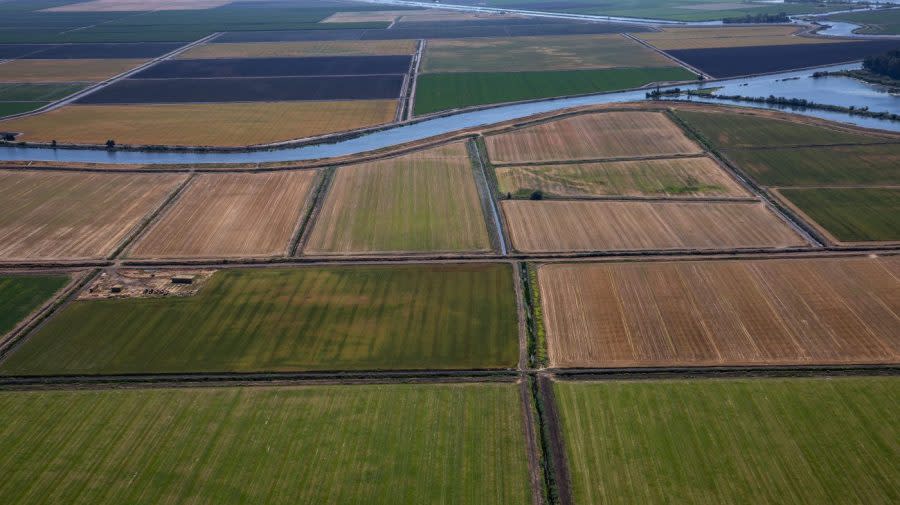California almond crop forecasts up 21 percent after wet and mild winter

Thanks to favorable weather conditions, California’s almond crop for 2024 is expected to be 21 percent greater than last year’s final output, the U.S. Department of Agriculture (USDA) reports.
The almond crop should amount to about 3 billion pounds, as opposed to the 2.47 billion pounds generated in 2023, according to the USDA’s National Agricultural Statistics Service Pacific Regional Office, based in Sacramento.
“The 2024 almond crop experienced fluctuating, but mostly favorable weather for the first half of the growing season,” a Friday analysis from the office stated.
The almond bloom began the second week of February for early varieties and initially faced “a handful of storms that brought rain, wind and hail” on a local level, per the analysis.
“But overall mild temperatures and excellent weather from the end of February into early March helped boost pollination,” the report added.
Growers described bee pollination hours as “significantly higher” than those of 2023. Although wet weather and warmer April temperatures raised risks of diseases and pests, there was minimal threat of frost conditions, the survey found.
Meanwhile, allocation of water — of which almonds require massive amounts for growth — was “not an issue for the second year in a row,” the analysis noted.
Mature almond trees in the southern Sacramento Valley can consume 41 to 44 inches of water in an average year when water use is unrestricted, while those in Central California’s San Joaquin Valley can use as much as 50 to 54 inches, according to data from the University of California, Davis.
The Almond Board stressed, however, that the water needs of almonds are similar to those of other tree fruits and nuts, such as pistachios, walnuts and peaches. Meanwhile, more than 80 percent of California almond growers now use efficient micro-irrigation techniques, the board noted.
The USDA’s 2024 projects came from an annual “subjective” forecast, which asked about 500 growers about both last year’s yield and this year’s expected output in a survey from April 19 to May 5.
Almond-bearing acreage stood at 1.38 million this year, unchanged from 2023 estimates, while yield amounted to 2,170 pounds per acre: 380 pounds greater than last year’s 1,790 pounds per acre, according to the USDA.
“This larger crop estimate is what the industry expected after a productive bloom this spring, but it is also a testament to the hard work done by almond farmers throughout California during difficult times,” Clarice Turner, president and CEO of the Almond Board of California, said in a Friday statement.
While the USDA estimates indicated that acreage remained unchanged, a report generated by Land IQ for the Almond Board two weeks ago showed a shrinkage in bearing acreage — the first time since 1995 that the territory has not expanded.
Land IQ, an agricultural and remote sensing firm, found that almond-bearing orchards at harvest would cover 1.373 million acres across California, constituting a 600-acre decrease in comparison to the previous year.
The positive projections for this year’s output have materialized, despite concerns about various natural and financial risks cited earlier this season.
In February, farmers detected a new invasive beetle species infesting almonds and pistachios in the San Joaquin Valley, prompting lawmakers to sound the alarm on a “major economic threat.”
Rep. Josh Harder (D) and several of his California colleagues wrote to the USDA to request emergency funding that could help mitigate risks linked to further invasion — by funding improved sanitation measures and research.
The next month, the Los Angeles Times reported that welcoming a decade of investment in-flows, the almond sector had “entered a slump” — as acreage shrunk and growers opted for other crops.
At the same time, a major almond-cultivating conglomerate declared bankruptcy, citing record-low prices and high interest rates as their reason for doing so, per the Times.
Nonetheless, the Almond Board on Friday touted this year’s successes — noting that if the USDA’s 3 billion-pound prediction holds true, this would be the second-largest almond crop on record for the Golden State.
“Demand for California almonds around the globe continues to grow,” Turner, the board’s CEO, stated. “Our almond farmers constantly deliver on producing high quality California almonds to meet that demand.”
For the latest news, weather, sports, and streaming video, head to The Hill.

 Yahoo Finance
Yahoo Finance 